Best Spearfishing Weight Belts
When freediving or spearfishing, you need to stay at a certain depth in the water for a given time. This isn’t always easy to manage on your own given that the natural buoyancy of the water will tend to push you towards the surface. The solution to this issue is a weight belt which will add you weight to allow you attain a certain depth much easier.
With weighted belts, you need to find the exact weight you need for yourself with aspects such as your body weight, the salinity of the water and the desired depth coming into play. Add too much weight and you sink too low, too little weight and you float too much.
Below, we take a look at some of the best weighted belts you can use for spearfishing, free diving or diving in general. These are belts are durable and reliable in many ways. This review is based on the weight they carry, their levels of adjustability and their reliability in staying in place when in use.
Cressi Weight Belt for Spearfishing & Freediving

The Cressi Weight Belt is made of rubber and comes with a quick-release stainless steel buckle. While a lot of weighted belts go for a black buckle, the Cressi has a corrosive resistant stainless steel one which works quite well in our experience. It’ll easily pass for a normal belt.
The rest of the belt is made of high premium rubber materials. If you choose to add weights on the belt, they will stay in place throughout its use given how the rubber is made. The Cressi belt has been created to hold weights since it has no weight of its own and it’s one of the best for this purpose.
Pros
- Premium rubber materials for longevity and durability.
- Quick release buckle ensures safe and easy usage.
- The buckle is made of stainless steel to prevent rusting and general damage.
Cons
- No weight of its own.
Even without weights of its own, the Cressi weight belt does a great job at keeping the weights in place and ensuring you’re comfortable when using it.
Picking one of these belts guarantees safety and the right depth in the water. You need to know the amount of weight you need to add to your body to counterbalance the water’s upthrust force. These belts can help you attain just that.
Riffe Freediving & Spearfishing Rubber Weight Belt
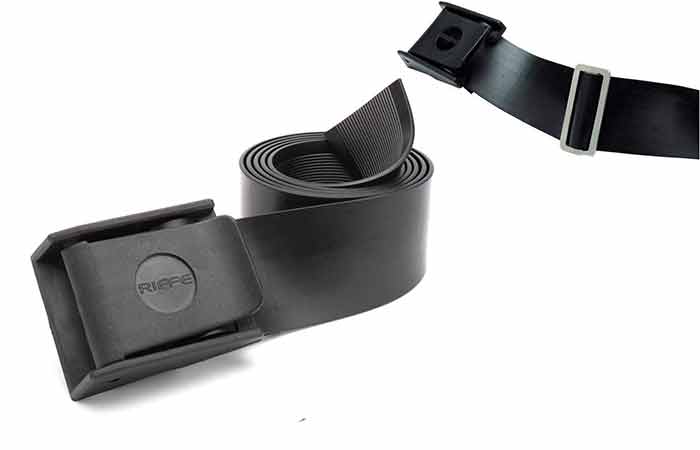
Second is the highly impressive Riffe Rubber Weight Belt with Buckle. The belt has a capacity of 20 lbs. which is a good weight for more divers. Even better, you can easily add heavy-duty stainless steel weight retainers (which are sold separately) to attain the weight you need.
This weighted belt comes with a cam-lock buckle which ensures that the belt stays in place no matter your activities underwater. The belt is made with a glass-filled nylon material which is highly durable and elegant to work with. If the belt is too long for you, you can easily cut it into the right length with a knife.
Pros
- 137 cm (54 inches) long to fit a large number of users.
- Can be adjusted by cutting it to size if it’s too long.
- The highly durable cam-lock buckle is made with glass-filled nylon.
- The belt weighs 20 pounds which meets the needs of a lot of divers.
- You can buy and add on the belt weight retainers for more weight and more depth.
Cons
- The belt needs a slightly thick piece of cloth under it since it can rub against the skin and cause chaffing.
This weighted belt would pass for a normal belt given its minimalist look. However, it packs great features which make it the best for freediving and spearfishing.
XS Scuba Eight Pocket Weight Belt
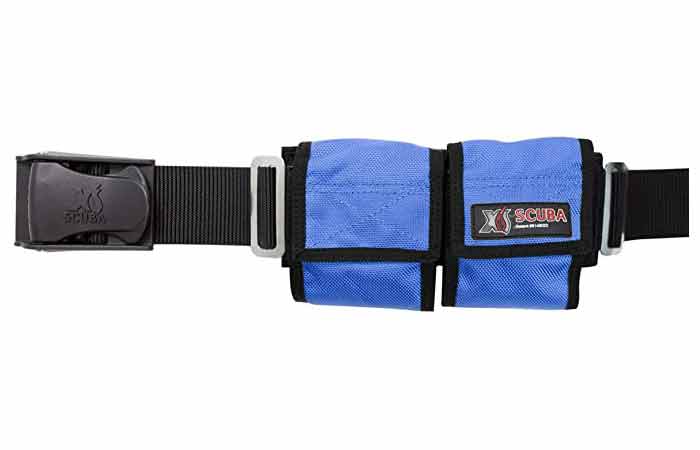
This belt comes with its own pockets where you can add weights to attain deeper levels in the water. Each pocket on the belt holds a weight of 5 pounds. Each pocket also has two smaller pockets inside each with 5 pounds weight capacity. For this reason, you can add 10 pounds to the belt by having only one pocket. When not in use, the Velcro pockets flatten out reducing drag on the body underwater.
Besides the cleverly-thought out Velcro pockets, the belt is made of high-quality materials such as the stainless-steel buckle and the rubber belt. Both of these won’t rust when used in salt water and will provide a secure fit for any user. In our use of this belt, we noted that you need to adjust the pockets on the belt so that they are well balanced out. This can be done by simply sliding them to one side.
Pros
- High quality materials for assurance and security.
- Secure buckle that won’t rust when used in salt water.
- Added pockets for extra weights when you need to attain deeper levels in the water. Pockets hold 5 lbs. each.
- Pockets flatten out when not with any weights reducing body drag in the water for faster movements.
- Pockets can be easily adjusted to the position one feels is comfortable.
Cons
- You need specific weights to use with this belt as some fall out of the pockets.
This is one of the most useful weight belts for spearfishing since you can add weights to attain just the right amount of weight to add to your body. Even better, the weights can be adjusted to weigh down the right places on the body such the front, back or the sides.
SEAC Nylon Buckle Rubber Belt
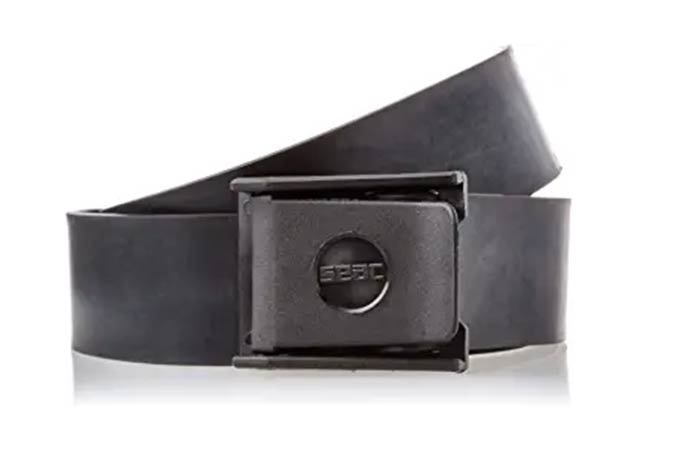
The SEAC Nylon Buckle Rubber Belt is one of the most reliable belts on the market thanks to the clever engineering. The buckle has a quick release mechanism making it safe for when you want to release it in an emergency. However, it provides a very secure fit and won’t let go unless you want it to.
The belt is made of elastic material which ensures that it contracts and compresses down as you descend into the water. It will also loosen up by expanding when you’re ascending from the water. This is in line with the wetsuit you will be using and it makes it highly comfortable to the user.
Pros
- High quality buckle and belt guarantee safety when in use.
- The belt expands and contracts with your level in the water to ensure you’re comfortable at all times.
- You can add weights in terms of the standard block weights or the soft lead shot in added pockets.
- Large users can also use it Thomas to waists up to 51 inches being accommodated.
Cons
- The weights might slide around a bit if they’re not the clip-on type.
For those who desire a weight belt that feels comfortable no matter the depth they are at in the water, this is the one.
Scuba Max Nylon Zippered Weight Belt
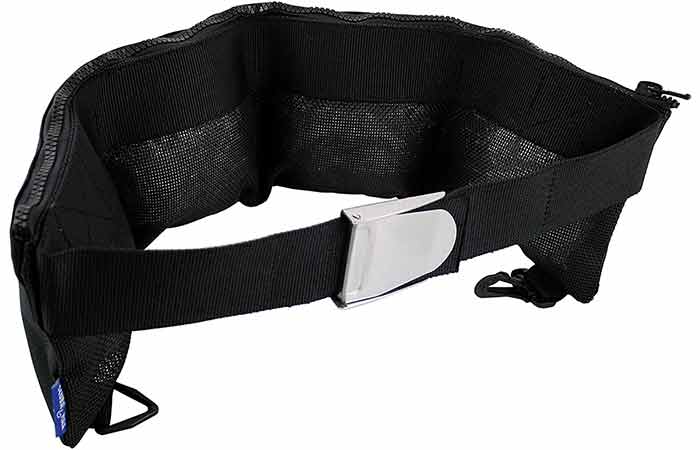
Next up is the Scuba Max Nylon Zippered Weight Belt with four weight pockets. It comes with a 4” nylon belt on either side of the weight pockets. With these weight pockets, you get to add the weights you desire in a good distribution on either side.
The buckle is made of stainless steel which ensures a strong and secure fit each time you use the belt. The other benefit of stainless steel is that it remains in good condition no matter how long you use it. The buckle also has quick release mechanism which ensures quick usage and safety.
Pros
- Stainless steel buckle ensures longevity when used in salty water.
- The buckle has a quick release mechanism for easy use and safety.
- It comes with four weight pockets to ensure you get just the right amount of weight for your diving sessions.
- Measures 30 inches long making it fit for most people.
Cons
- The 30 inches of waist may not accommodate larger users.
This belt is one of the best thanks to the four weight pockets which distribute weight evenly around the body. We wish it was longer though.
Scuba Choice Spearfishing Free Dive Heavy Duty Rubber Weight Belt
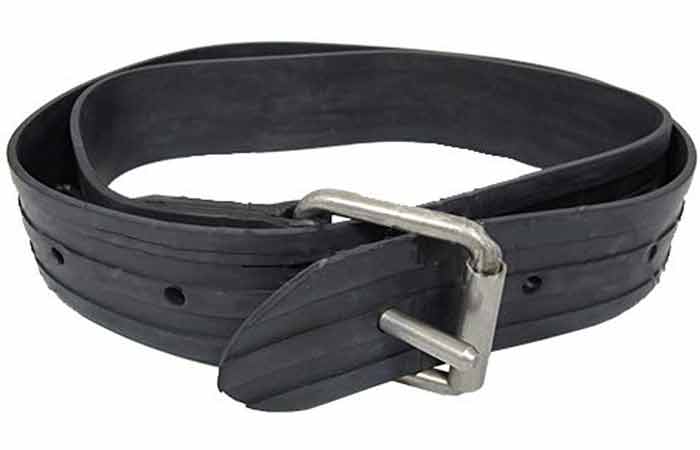
This Scuba Choice Spearfishing Weight Belt adopts the classic belt design with a stainless-steel buckle that uses holes rather than the quick-release buckles. If you prefer something simple and steady, this belt is just that. The stainless steel buckle will last ages without issues.
The belt can have weights added to it. Being made of rubber, it expands and contracts with the depths you attain in the water. This makes it comfortable throughout your diving experiences. The other benefit is that you can adjust the belt without the need to cut it for those with smaller waists. You simply make a hole on it.
Pros
- Available in two sizes of 53” (1.3M) and 61” (1.5M) to fit different users.
- The stainless-steel buckle is sturdy and will resist corrosion and rust.
- You can add weights to the belt at different places for a good balance.
- The rubber belt expands and contracts in relation to the depth attained.
Cons
- The belt’s buckle doesn’t have a quick release mechanism.
We love the simple yet highly reliable workings of this belt. It can pass for just about any other type of belt given its classic look and works just as well.
Scuba Diving 60” Long 2” Webbing Belt with Plastic Buckle

Available in black, blue, lime and yellow, the Scuba Diving Belt from Scuba Choice is one of the very best when it comes to adding weight to your body for freediving and spearfishing. It’s also one of the longest thanks to its 60 inches of length which means even large users are well accommodated. Thankfully, you can even cut it into the desired shape.
The buckle is made of hard plastic which makes it highly durable. You can add weights on the belt as you see fit. The belt will ensure the weights don’t slide around given the nylon webbing material it’s made of. We loved its simple look and the ability to adapt to any type of added weight.
Pros
- Long 60-inch belt for larger users. The belt can be cut to size with a knife.
- Plastic buckle provides a lightweight yet secure fit for the user. The buckle is also easily removable thanks to the quick release mechanism.
- Available in different colors to accommodate different looks and match wetsuits.
- Nylon webbing material is reliable and comfortable on the body.
Cons
- The webbing can get thin in certain areas after long periods of use.
If you’re looking for a light belt that can still accommodate weights, this one fits that description quite well.
What to look for when buying weight belts
To get the best belt for your spearfishing or freediving activities, look for the following aspects in a weight belt:
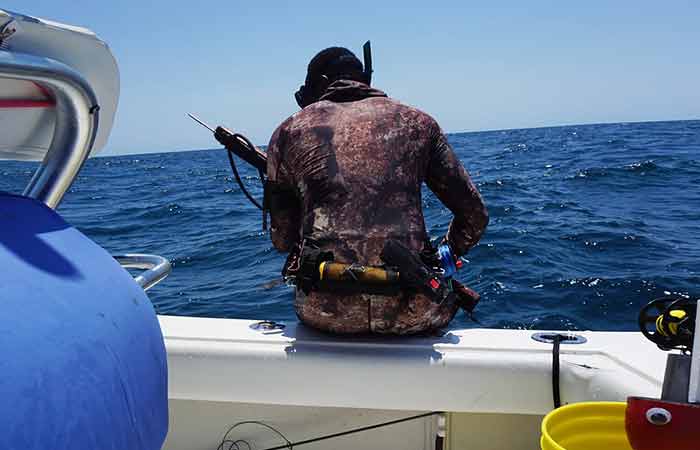
They style of the belt
First, check for the style of the belt you want to buy. In this category, there are belts with holes and those without. Either way, each of these should be adjustable to the size you desire. On the other hand, each of these belts should be able to fit you without being too tight or too loose.
If a belt without holes is too loose, you should consider cutting it to size. Always cut the belt leaving some extra length to avoid cutting it too short such that it doesn’t fit or fits too tightly. If such a belt is too tight, you just need to get a new one. If you cut a nylon belt, you will need to lock the cut end or else it’ll fray and shorten even further. To avoid such a case, always buy a weight belt at least 5 inches longer than your own waist.
If a belt with a series of holes is too long, you can choose to make a hole to your size on it. While it isn’t recommended by the manufacturers, it’s better than cutting it. Making one extra hole doesn’t compromise the sturdiness of the belt and still makes the belt usable by larger users.
The belt material used
In terms of the material for the weight belt, you have a choice between silicone, rubber and nylon. Each of these materials is suited to different conditions given that they have different properties. A majority of the freedivers use rubber more than the other materials given the qualities of rubber to stretch and contract in different conditions.
For freediving, go for rubber and silicone weight belts as they stay close to your body and will not loosen up like nylon ones which can easily move from the waist to the chest as you go deeper into the water. Rubber will stretch then compress again to remain in the same position on your body.
Rubber is also great if you need to add more weights to the belt. Rubber will retain its shape even with the weights. Nylon, on the other hand, will grow thin in some areas which can make it very uncomfortable to use. Also, while rubber will recover its shape once you come out of the water, nylon won’t do so.
This doesn’t mean nylon is hopeless in comparison to rubber for making weight belts. If you are to choose nylon, make sure it’s very thick such that it doesn’t stretch in some areas when you add weight to it. It should be stiff such that it doesn’t fall apart when you use it in the water.
The type of buckle used
With buckles, you have a choice between nylon plastic buckle or quick release, stainless steel quick release or the stainless-steel traditional buckle. All belts are of a high quality although steel is better than nylon thanks to its long life and resilience when used in harsh conditions. Nylon, while a great material, doesn’t do well when left outdoors on the sun especially as it’ll grow brittle and break apart.
Another aspect is to consider the safety of the belt. Having a quick release buckle is better if you dive in areas with lots of obstacles. This helps you quickly let go of the belt in the case of ana emergency. If the area is free of obstacles, the traditional buckle is enough.
Pockets
With pockets on the weight belts, you have a choice between removable, adjustable or stitched on pockets. Each of these designs has its upsides and downsides. For example, we prefer the removable pockets since you can add them only when you need to do so. The problem with that is that you have to buy the weights and the pockets to use the belt properly.
The adjustable belts are also great as they allow you move the weight right where you need. For example, you might need to have more weight on the side and moving the weighted pockets to that region is as easy as sliding the pockets to the side.
The stitched options are quite complex. Their advantage is that you have a belt that’s ready to accommodate weights. The problem is that you will have less freedom when it comes to removing weights or shifting the weight to the desired location on the body.

